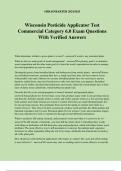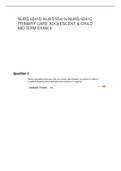©BRAINBARTER 2024/2025
Wisconsin Pesticide Applicator Test
Commercial Category 6.0 Exam Questions
With Verified Answers
What determines whether a given plant is a weed? - answer✔A weed is any unwanted plant
What are the two main goals of weed management? - answer✔The primary goal is to minimize
weed competition and the other main goal is to limit the weed's reproduction in order to manage
the weed population in years to come.
Distinguish grasses from broadleaf plants and herbaceous from woody plants - answer✔Grasses
are considered monocots, meaning they have a single seed leaf, they also have narrow leaves
with parallel veins and a fibrous root system. Broadleaf plants have two seed leaves and are
therefore called dicots, they have broad leaves with veins that form a net patterns. Broadleaf
plants can be further classified into herbaceous and woody, where the woody plants have a thick
layer of dense tissue called bark, which herbaceous plants lack.
Describe the life cycles and propagation of annual, biennial, and perennial plants -
answer✔Annual plants live for less than a year, they produce many seeds in one growing season,
and then die. Summer annuals winter as seeds, and winter annuals winter as a low-growing plant,
both summer and winter annuals are easiest to control when they are small. Biennial plants live
for two growing seasons, they germinate from seed in the spring or summer and winter as a
rosette of leaves. They flower in their second year, produce seeds and then die. Both annuals and
biennials reproduce only by seed. Perennial plants live for at least 2 years and sometimes longer,
they may reproduce by seed or vegetatively through several different mechanisms.
What is needed to kill annual, biennial, and perennial weeds and when is it easiest to do so? -
answer✔To kill annuals or biennials, you must kill the whole shoot. Controlling these weeds
with tillage or herbicides will kill them plus stop seed production, which will reduce future weed
problems. The most effective way to kill perennials is to destroy the underground vegetative
structures by either repeatedly tilling the soil or by using a herbicide that translocates to destroy
all of the plant parts.
How should you time herbicide application with respect to a plant's life cycle and which timing
is most effective? - answer✔All weeds may start as seedlings and it is most effective to treat the
, ©BRAINBARTER 2024/2025
plants at this stage because less energy is required to kill the plants at this stage than at any other.
Biennials and Annuals are controlled by a fall or early spring treatment, and perennials are
controlled best with a fall treatment as well.
What are the effects of soil texture and organic matter content on application of soil herbicides? -
answer✔Soil organic matter and clay particles can adsorb soil-applied herbicides, meaning more
herbicide will be required in these types of soils because the herbicide will be bound to the soil
particles and will not be available to be absorbed by the weeds.
How do you keep soil herbicides from moving off target? - answer✔Do not apply herbicides to
areas where they may leach into groundwater, or run off into water sources or cropping areas.
Also avoid applying herbicides to areas where desired tree and shrub roots may extend and DO
NOT apply herbicides to frozen soils.
How and when should you apply soil herbicides? - answer✔Soil treatments are commonly used
when a site requires residual non-selective control, such as electric transformer stations, rail
ballasts and signpost bases. They can be applied any time that the soil is not frozen, and some
soil applied herbicides need to be transported by rain to be absorbed by the plant.
When are foliar sprays appropriate and not appropriate? - answer✔Foliar sprays are not
recommended for large brush because of the potential for drift. Foliar sprays should be operated
from the ground close to the plant and can either be applied through broadcast or spot
application.
What are the factors in timing a foliar spray? - answer✔Foliar treatments can be made from the
time the leaves are fully expanded until they begin to turn color in the fall, but are most effective
when applied to fully developed foliage of an actively growing plant. They should be applied at a
temperature between 60 and 80 degrees F, and should have adequate time to soak into to plant,
thus applying right before it rains is ineffective.
How are adjuvants used most effectively? - answer✔Adjuvants may be necessary to use for
better absorption by foliage that is extremely waxy or hairy.
What are the similarities and differences between foliar, cut-surface, and basal bark applications?
- answer✔Foliar applications are put directly onto the foliage of a growing plant. Basal bark
applications are used to control shrubs, canes and thickets or trees up to 5 inches in diameter and
are applied to the lower 18 inches of the stems. Cut-surface treatments are used to control plants
with thick bark or when they have trunks larger than 5 inches in diameter at the base.
Define and explain "pesticide". - answer✔A pesticide is any substance used to directly control
pest populations or to prevent or reduce pest damage. Pesticides can range from anything such as
an insecticide to a herbicide to a fungicide.
, ©BRAINBARTER 2024/2025
What is the difference between organic and inorganic? - answer✔Organic means the compound
contains the element carbon, it does not mean it is natural. Inorganic means that the it is derived
from minerals that occur in nature.
What is the difference between the different types of pesticide names? - answer✔Chemical
name: complies with accepted guidelines established by chemists.
Common name: normally appear on the label before or above the chemical name and refers to an
active ingredient.
Trade name: the name given by the manufacturer, appears in large letters at the top of the label
Compare selective and non-selective herbicides: - answer✔Selective herbicides only harm
certain plants and leave others unharmed. Non-selective herbicides are toxic to most or all plants.
What are the uses and characteristics of contact and systemic herbicides? - answer✔Contact
herbicides do not move within the plant, they are sprayed on and only kill the parts of the plant
they actually touch. Systemic herbicides are absorbed through leaves or roots and then mover or
translocate within the treated plant.
What are the effects and uses of plant growth regulators? - answer✔Plant growth regulators do
not kill plants, but are used to increase, decrease, or change in some fashion the normal growth
and or reproduction of the plant. They may be used to retard plant growth and reduce the need
for other chemical or mechanical management measures.
Describe the function of inert ingredients: - answer✔They do not possess pesticidial activity but
are added to improve application effectiveness, safety, handling, storage or other characteristics
of the final product.
Why are there different kinds of formulations and what needs to be considered when selecting
one? - answer✔The chemistry of the active ingredients dictate which formulations are possible,
so when selecting a formulation the following should be considered: effectiveness of the active
ingredient, registered use of the active ingredient, risks to the user, treated site and environment,
measurability of the formulation, characteristics of the formulation and how they will effect
equipment, temperature at which the formulation needs to be stored ect.
Which formulations applied as liquids do the following: form suspensions or solutions when
diluted, require agitation in the spray tank after mixing, tend to clog nozzles, are abrasive or may
cause sprayer parts to deteriorate, and are likely to cause phytotoxicity. - answer✔Emulsifiable
concentrates form milky suspensions and require minimal agitation to keep the suspension
uniformly mixed. Water-soluble concentrates and soluble powders are both true solutions in
water and are non abrasive. Dry Flowables form a suspension in water and require some
agitation in the spray tank, they are abrasive to sprayer components. Flowables or suspension
concentrates are not soluble in water and they form suspensions that require moderate agitation,






